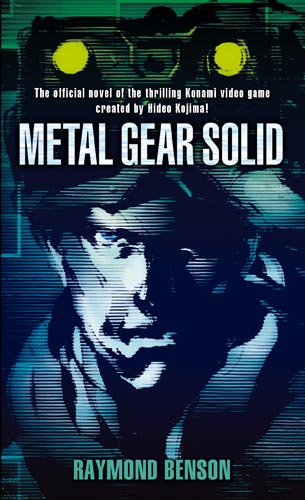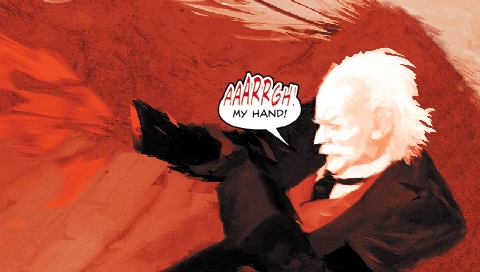Metal Gear Solid Novelization Break down (Part #1 Impressions)
March 27th, 2009

I was going to cram all of this into one mammoth article, but I’ve been a bit behind the ball with posting lately (no shortage of ideas though, just other distractions) and there is more than enough hear to fill a regular article. So here is part one of my thoughts on the MGS novel. The second part is a comprehensive list of all the differences between novel and game.
Background
Back in November last year while studying abroad in Shanghai, I by chance stumbled upon a novelization of the original Metal Gear Solid in one of the many bookstores just off the People’s Square. Far too entrenched in the Chinese lifestyle and language, I decided to read the book once I returned home in Australia, and over the past few weeks I’ve been just doing that. These are my thoughts.
Metal Gear Solid (novel) was published as a paperback on May 27, 2008 in America and over a week later in Europe on June 5, 2008. The novel was written by Raymond Benson, most notably known for his contributions to the James Bond series of novels between 1997-2003. Metal Gear Solid is the depiction of the events of the Shadow Mosses incident just as it were in the original video game.
General Impressions (Review)
Metal Gear Solid is by no means a reinterpretation of the original Shadow Mosses incident. The book rarely delves deeper into the characters, plot or themes any more so than I believe Hideo Kojima’s script would allow, rather author Raymond Benson is mostly a scribe for the game, intervening with the text where possible and necessary, often doing so to great effect.
This isn’t so much a review of the storyline as it is the novelization of the video game, so the documenting of the already static sequences (codec conversation and cut scenes) aren’t really worth discussing. Benson writes as these sequences purpose, and captures the essence of the cut scenes and codec sequences well.
When it comes to what one might call the player narrative though, Benson’s experience within the espionage writing genre is faithful to the Metal Gear Solid experience and lore. What was once your own means for tackling the game, has now become ingrained in the Solid Snake character. Where as a player might rely on a knowledge of conventions they’ve learnt from other games, Snake’s methodology is based upon lessons taught to him Master Miller, prior experiences in the field and training. Perhaps Benson’s greatest strength in this book is substantiating Snake’s prior knowledge and then channeling this back to the relevant characters, plot and dialogue at hand. This makes Snake’s mindset seem all the more real. Snake’s tactics within the natural environment draw on his experience of living in Alaska, his combat derived from lessons taught by Master Miller, dialogue from Campbell, Naomi and Mei Ling’s relevant to the chaos unfolding. Miller in fact is heavily called upon, replacing Mei Ling as the feature’s Confucious of wisdom.

The necessary intervention at the point of where video games and writing don’t meet (the player) allows Benson to better contextualize Snake as a character. When he changes the already fixed narrative itself, the book become a little problematic, as he’s clearly playing with things he perhaps shouldn’t be. Thankfully, beyond the few exceptions where he does this, the story is just as you remember it.
It’s difficult to say if I would recommend this book, as the text is only fodder to picturize the game unfolding in your head. If you haven’t ever played the video game then, I’d probably recommend you play that, rather than read about it. I doubt that the hybridized interactive manga/film/comic narrative translates outside of the medium that it was born. Overall though, this is a faithful, solid adaption of Metal Gear Solid to another format. Word has it that the sequel is also received an adaption by the same author, should be interesting.
Artwork pinched from Creative-Uncut
Ingrained Japanese culture and handling of Chinese Ethnicity within the Metal Gear Universe
March 25th, 2009
Lots of Metal Gear Solid spoilers, and a pretty deep look into the lore, so you’ve been warned!
***
This post was originally going to be about how Solid Snake is a terrible representation of an American born Chinese, but on going over my fact checking I realized that he is actually Japanese/American, surrogated through a Chinese mother (EVA).
I was a little dumbfounded at this revelation when watching the video that re-affirmed this for me (1:50). Mentioning of the Japanese egg donor (IVF process) seemed a little suspect, as it just appear hammed in there. I mean, it appears as though the developers simply wanted to clarify and cement the fact that Snake is actually Japanese, and not of Chinese ethnicity, the latter which would be an easy assumption given the events of MGS3, EVA’s titular title of Big Mama and how she openly states that she is Snake’s mother.
I can see how this was perhaps needed to justify the lines of Vulcan Raven in MGS1, but it does feel very self conscious of itself, that Snake is not Chinese. It really wouldn’t matter either way but consider these two previously glossed over points:
Mei Ling’s odd representation in the later half of MGS4. As I’ve mentioned before, strange, nonsensical, award sexual innuendo that makes her appear unexpectedly ditsy, particular in contrast to her more respected role in Metal Gear Solid. I just find that these two identities don’t match at all.
As I also lightly discussed earlier on this blog, EVA has no hints of being Chinese. No accent, blonde hair and unmistakably western appearance. In one of the games she justifies this (I honestly can’t recall, nor find it) but the justification that an archetypal, western Bond Girl is actually of Chinese ethnicity is a terribly hard sell.
These three ultra subtle clues, suggest some minute, no doubt culturally ingrained influences that have naturally flowed into the development process of this game. I don’t raise these points to be in any way contentious, rather, they make an interesting example of the way in which culture naturally affects video game development, as it would anything else. That we should be conscious of these hints, because, while seemingly insignificant, they are very important in the grander message.
Metal Gear Solid Novel, Narrative and Translation
November 15th, 2008
Last Saturday, I accompanied my friend to a street just off the People’s Square, in search for a book store that had particular classic english novel that she was after. Actually this street is popular for its book stores, with about four or five multi-storied stores on the one road. We ducked into a foreign book store and took a squiz, and you wouldn’t believe what I found;

That’s right a novelization of Metal Gear Solid. This was released back in May this year, quite a good find I’d say. So as you can imagine I decided to snap this one up with great haste and a big smile on my face. My decision to pick this up was prompted by a few ideas that have been bouncing around my head relating to video game narrative.
Loose Ideas
Video game narrative more often than not leans to strengths not completely associated – but indeed familiar – with the medium itself. ie. narrative embedded outside of gameplay. The reason for this is obvious, it is a lack long time video game narrative experience met with a marvel of complexities. Forming am effective narrative out of a complex experience such as playing a video game, must be a frightening task. That is, if you do so without using techniques like cut scenes and so forth.
Furthermore a good video game narrative also needs to fit within the context of a video game. Firstly there has to be enough substance to constitute gameplay. Secondly, what occurs in the game should justify and create the narrative itself, you have to participate in it, as such. Spending hours killing monsters has to be useful for something beyond keeping you busy, right? Then the narrative should work within a balance of levels, characters (both playable and non) and other game based variables.
While I think that there is without a doubt some incredible video game narrative in existence – the best of which conforms to the previously explained rules – no doubt, much of it is sort of hybrid. What I mean is that, some narrative you get to play, some narrative unfolds as you play and other narrative is statically presented to you. This is by no means bad or good, since even a game with completely separate narrative and gameplay can still have good narrative. What it means though is that, largely, narratives made in games, with some significant association to play are more or less exclusive only to this medium.
Translation
I’ve been thinking a little about translation recently. The reason being is that my most troublesome problem my Chinese language development, is English. For my Chinese to improve to a higher degree, I need to start thinking in Chinese instead of in English. In a sense I need to step out of myself and focus just on meaning and what I want to say, with the exclusion of language. The reason is that each medium has its own though processes involved with it, this is why as English speakers we are use to precision while Chinese speakers are not so specific with what they say. Video games are the same.

Metal Gear Solid has seen a lot of translation and been has already translated into a radio drama, comic, digital comic and novel. I wonder then how interpretation has changed across each of these and how derivative they are of the video game. The other interesting part of the translation is adaption. That is how the ‘game playing’ elements are adapted to mediums in which involve no participation. Something has to be done by the translator to silence the nuances between the mediums. So I am curious to see how the playable parts of MGS were handled.
Of course, I want to use these ideas for when I read the book and later document my thoughts (and probably when I get home and look into the digital novel too). Already the first chapter begins with a sequence long before the events on Shadow Mosses island, not shown in the video games.



 Game Design Companion: A Critical Analysis of Wario Land 4 - $7.99
Game Design Companion: A Critical Analysis of Wario Land 4 - $7.99 Level Design: Processes and Experiences
Level Design: Processes and Experiences Speed Boost: The Hidden Secrets Behind Arcade Racing Design - $5.99
Speed Boost: The Hidden Secrets Behind Arcade Racing Design - $5.99 Adventures in Games Analysis: Volume I - $5.99
Adventures in Games Analysis: Volume I - $5.99







